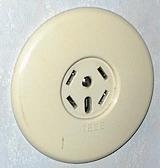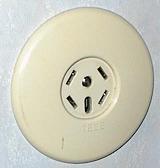
Swedish telephone plugs & sockets
Encyclopedia
A standard Swedish telephone plug carries one telephone
line and has four flat metal pins and one plastic pin. The design is only used in Sweden
and older installations in Iceland
(RJ11 and a data/voice standard using an 8P8C modular connector
are used in more recent buildings). Neither plug nor socket is compatible with other plugs and sockets. It is defined in Swedish Standard SS 455 15 50.

at the same time. This is done by connecting the two upper receptacles of a socket to the lower receptacles of the next socket. When a connected telephone's handset is lifted the two twisted pair
connections are separated, thus disconnecting any telephones downward in the chain.
The plastic pin adds a presence function. When not inserted into a jack, the jack itself (mechanically) connects the incoming line to the next socket.
The cascade topology makes installing a DSL splitter a matter of plugging it in the first socket since this socket provides both direct access to the PSTN and connections to the remaining sockets.
can be found. Most telephone equipment sold in Sweden today has RJ11 sockets and corresponding cables with 6P4C plugs on each end and an adaptor from RJ11 to SS 455 15 50 sockets. The Swedish practice with sockets connected in cascade can be maintained with RJ plugs and sockets by using the first pair for connecting the terminal equipment to the PSTN and the second pair for the connection of a line towards the next socket. However, the presence function found in Swedish Standard sockets is lost, so disconnecting a telephone from its socket requires replacing it with a dummy plug so the sockets further down in the chain will remain connected.
6P6C modular plugs are also used for telephony, but only for certain telephone exchange systems - never for direct connection to the PSTN. ISDN telephones and outlets always have 8P8C modular connectors.
Telephone
The telephone , colloquially referred to as a phone, is a telecommunications device that transmits and receives sounds, usually the human voice. Telephones are a point-to-point communication system whose most basic function is to allow two people separated by large distances to talk to each other...
line and has four flat metal pins and one plastic pin. The design is only used in Sweden
Sweden
Sweden , officially the Kingdom of Sweden , is a Nordic country on the Scandinavian Peninsula in Northern Europe. Sweden borders with Norway and Finland and is connected to Denmark by a bridge-tunnel across the Öresund....
and older installations in Iceland
Iceland
Iceland , described as the Republic of Iceland, is a Nordic and European island country in the North Atlantic Ocean, on the Mid-Atlantic Ridge. Iceland also refers to the main island of the country, which contains almost all the population and almost all the land area. The country has a population...
(RJ11 and a data/voice standard using an 8P8C modular connector
Modular connector
Modular connector is the name given to a family of electrical connectors originally used in telephone wiring and now used for many other purposes. Many applications that originally used a bulkier, more expensive connector have now migrated to modular connectors...
are used in more recent buildings). Neither plug nor socket is compatible with other plugs and sockets. It is defined in Swedish Standard SS 455 15 50.

Sockets connected in cascade
When there is only one socket in a house or apartment, the incoming line is connected to the two lower receptacles and the upper receptacles are left unused. When a subscriber has more than one telephone socket, they typically are connected so that two telephones can not be connected to the telephone exchangeTelephone exchange
In the field of telecommunications, a telephone exchange or telephone switch is a system of electronic components that connects telephone calls...
at the same time. This is done by connecting the two upper receptacles of a socket to the lower receptacles of the next socket. When a connected telephone's handset is lifted the two twisted pair
Twisted pair
Twisted pair cabling is a type of wiring in which two conductors are twisted together for the purposes of canceling out electromagnetic interference from external sources; for instance, electromagnetic radiation from unshielded twisted pair cables, and crosstalk between neighboring pairs...
connections are separated, thus disconnecting any telephones downward in the chain.
The plastic pin adds a presence function. When not inserted into a jack, the jack itself (mechanically) connects the incoming line to the next socket.
The cascade topology makes installing a DSL splitter a matter of plugging it in the first socket since this socket provides both direct access to the PSTN and connections to the remaining sockets.
Sockets connected in parallel
When all sockets on a line are connected in parallel only the lower pins on a Swedish Standard plug (middle connectors on RJ-plugs) are used. This configuration was earlier not allowed due to Swedish law prohibiting the possibility of eavesdropping on a telephone line (and possibly also to limit each household's load on the exchange). Parallel connection of sockets are now allowed but can be considered bad practice by some, and makes DSL splitter installation more cumbersome. The advantages include compatibility with foreign equipment and conference call-type communication.Other connectors used in Sweden
In addition to the standard Swedish plugs and sockets, RJ11 connectors are quite common, especially in offices. Even 8P8C modular telephone socketsModular connector
Modular connector is the name given to a family of electrical connectors originally used in telephone wiring and now used for many other purposes. Many applications that originally used a bulkier, more expensive connector have now migrated to modular connectors...
can be found. Most telephone equipment sold in Sweden today has RJ11 sockets and corresponding cables with 6P4C plugs on each end and an adaptor from RJ11 to SS 455 15 50 sockets. The Swedish practice with sockets connected in cascade can be maintained with RJ plugs and sockets by using the first pair for connecting the terminal equipment to the PSTN and the second pair for the connection of a line towards the next socket. However, the presence function found in Swedish Standard sockets is lost, so disconnecting a telephone from its socket requires replacing it with a dummy plug so the sockets further down in the chain will remain connected.
6P6C modular plugs are also used for telephony, but only for certain telephone exchange systems - never for direct connection to the PSTN. ISDN telephones and outlets always have 8P8C modular connectors.
Reference and further reading
- Description of Network Interfaces ; Analogue Access to PSTN from TeliaTeliaTelia may refer to:*Telia - part of the reproductive cycle of Rusts*Telia Digital-tv - a Swedish TV platform*Telia, Nepal - a village in Nepal*TeliaSonera - a Swedish/Finnish telecom operator*Telia Challenge Waxholm - Golf tournament...
(pdf)

